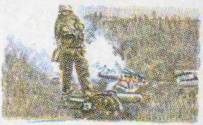Stephen Andrews searches the internet for images not seen in the press: the consequences of ‘collateral damage’ and ‘friendly fire’, grieving civilians, soldiers marking time, the torture and humiliation of prisoners. He draws these photographs in coloured crayons rubbed over window screening, reproducing the effect of a halftone screen. The Canadian artist renders dispassionately, in the palette of the nursery, but instead of serving to distance us from the images, he memorialises what has been erased, and by virtue of his solemn diligence, makes visceral what has been repressed. Most arresting of all, an animation made from hundreds of these drawings continuously replays a scene in which a soldier extinguishes burning wreckage in which lies the body of a dead Iraqi man. The soldier’s nonchalance amplifies our revulsion at this incident of grisly death, but the artist’s investment of labour and attention in drawing each instant of the original event pays every second of this brief but appalling document a kind of respect, an acknowledgement of its gravity. With his elegiac practice, Andrews imbues the war’s horror with a reverence not otherwise found in our daily consumption of images from the front.
Image: Stephen Andrews, The Quick and the Dead 456, 2004
Crayon on paper (animation cell) - 14 x 22.9cm
Courtesy Rubicon Gallery, Dublin
![Critical Voices 3 [Main Logo] Click for home](/images/cv3_logo.gif)


